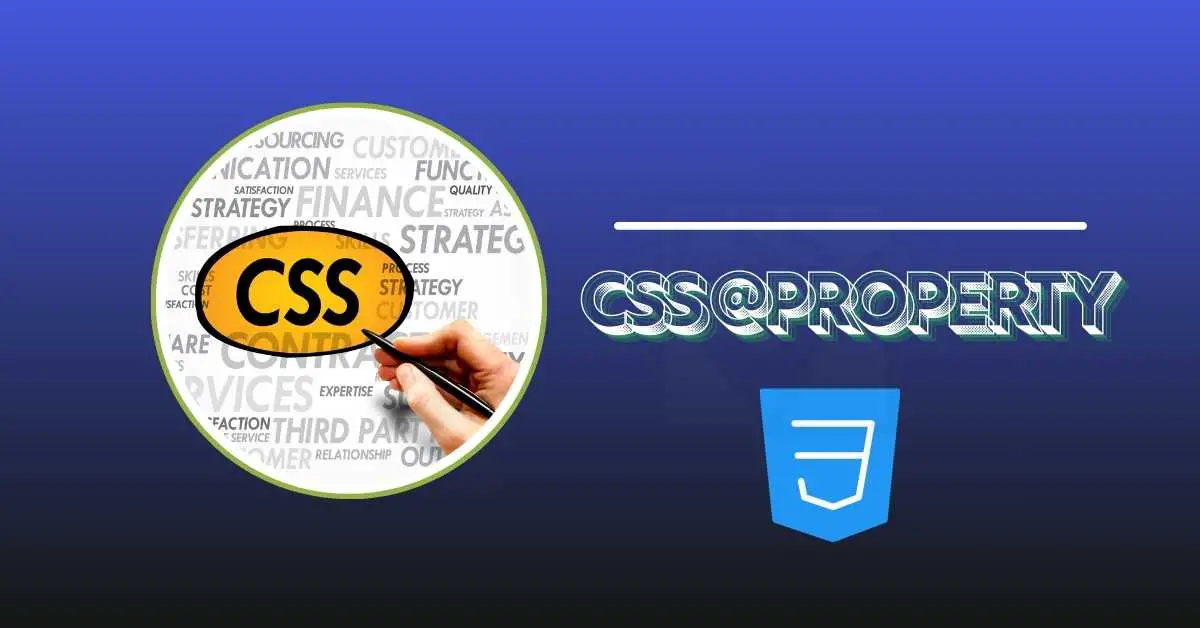|
Getting your Trinity Audio player ready... |
CSS has evolved significantly in recent years, introducing new features to make styling web pages more dynamic and efficient. One such feature is the CSS @property rule, which comes as part of the CSS Houdini specification. It allows developers to create and define their own custom properties (often referred to as CSS variables) with enhanced control over their behavior, offering new possibilities for dynamic, type-safe styling. This article will explore what @property is, its syntax, and how you can use it to create more powerful CSS variables.

CSS @import: A Guide to Importing Stylesheets
Understanding CSS @layer-Guide
What is @property?
The @property rule is a part of CSS Houdini, a set of APIs that enable developers to extend CSS and provide more control over styles. While traditional CSS variables (--custom-property) are widely used, they don’t have type validation or default values built-in. The @property rule enhances the capabilities of CSS variables by allowing you to define the type, initial value, and whether a custom property should be able to inherit values.
For example, you can specify that a variable is a number, color, or length, ensuring that the browser treats it correctly when it is used in styles.
Syntax of @property
The @property rule is simple to use. Here’s its basic syntax:
@property --custom-property-name {
syntax: '<type>';
initial-value: <value>;
inherits: <true | false>;
}--custom-property-name: The name of your custom property, just like traditional CSS variables.syntax: The data type of the custom property, using CSS’s syntax definition. For example,'<color>','<number>', or'<length>'.initial-value: The default value if the custom property is not explicitly set.inherits: Determines whether the custom property can be inherited (trueorfalse).
Example of Using @property
Let’s look at an example where we define a custom property for a rotating element’s angle. We want this property to behave as a number (representing degrees of rotation), have an initial value of 0, and not be inherited.
@property --rotation-angle {
syntax: '<angle>';
initial-value: 0deg;
inherits: false;
}
.rotating-element {
transform: rotate(var(--rotation-angle));
transition: transform 0.5s;
}
.rotating-element:hover {
--rotation-angle: 45deg;
}In this example:
- We define
--rotation-angleas a custom property with an initial value of0deg. - The element will rotate by 45 degrees on hover, using the defined property.
This is a simple example, but the power of @property comes in its ability to work with more complex animations and responsive designs where control over custom properties can make styling more efficient.
Advantages of @property
- Type Safety: By specifying the data type for custom properties, you ensure that invalid values are not applied. For example, if a custom property is defined to accept a
<color>, the browser will throw an error if a non-color value is passed. - Default Values: You can provide a default value for your custom property, ensuring that the element has a fallback if the property is not defined elsewhere in your stylesheet.
- Inheritance Control: The
inheritsoption gives you control over whether custom properties should be passed down to child elements. This adds flexibility when working with complex layouts. - Better Animations: When using
@propertywith custom animations, the browser can optimize the animation, ensuring smoother transitions and better performance compared to traditional CSS variables.
Browser Support
As of now, @property is supported only in Chromium-based browsers like Google Chrome and Microsoft Edge. Firefox and Safari have not yet implemented support for this feature, so it’s important to include fallbacks when using @property in production.
Fallback for Unsupported Browsers
Since @property is not yet supported across all browsers, it’s essential to provide fallbacks. For instance, you can use traditional CSS variables for browsers that don’t support @property:
/* Traditional CSS variable as a fallback */
.rotating-element {
--rotation-angle: 0deg;
transform: rotate(var(--rotation-angle));
transition: transform 0.5s;
}
.rotating-element:hover {
--rotation-angle: 45deg;
}
/* @property for supported browsers */
@property --rotation-angle {
syntax: '<angle>';
initial-value: 0deg;
inherits: false;
}In this way, the custom property will work as expected in browsers that support @property, while other browsers will gracefully fall back to using the traditional CSS variable.
Use Cases for @property
Here are a few scenarios where @property can be highly useful:
- Complex Animations: You can define custom properties for different animation parameters, like rotation, scale, and skew, giving you more control over the animation’s behavior.
- Responsive Designs: Using
@propertycan help you define responsive values for properties like padding, margins, or font sizes that dynamically adjust based on user interaction or screen size. - Theme Customization: Custom properties defined using
@propertyallow you to build flexible themes that can be adjusted by users, ensuring the correct types of values are used for colors, spacing, and layout.

Conclusion
CSS @property opens up new opportunities for creating dynamic, type-safe custom properties that extend the capabilities of CSS variables. Although browser support is still limited, its potential for building more maintainable, optimized styles is immense. As part of the CSS Houdini API, this feature paves the way for even more powerful web styling in the future.
Start experimenting with @property to see how it can help you build more robust and efficient web designs!
For more articles on CSS and web development, check out Makemychance.com.
Arsalan Malik is a passionate Software Engineer and the Founder of Makemychance.com. A proud CDAC-qualified developer, Arsalan specializes in full-stack web development, with expertise in technologies like Node.js, PHP, WordPress, React, and modern CSS frameworks.
He actively shares his knowledge and insights with the developer community on platforms like Dev.to and engages with professionals worldwide through LinkedIn.
Arsalan believes in building real-world projects that not only solve problems but also educate and empower users. His mission is to make technology simple, accessible, and impactful for everyone.



